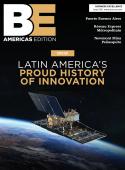Road to prosperity┬áWhen the local economy is feeling the pinch of rising prices and fewer jobs, thereÔÇÖs nothing like a big infrastructure project to redress the balance. John OÔÇÖHanlon learns about Lawrence ConstructionÔÇÖs I-25 upgrade at Trinidad, Colorado, from project manager David Morris. Though it has a population of fewer than 10,000 souls, the city of Trinidad, Colorado, is a vibrant and attractive place, welcoming up to a half million tourists a year who want to see its historic 19th-century buildings or use it as a center to explore the Raton Mesa and the pretty Purgatoire River. Or they may want to find out about the Santa Fe Trail, which ran through Trinidad and is said to have been AmericaÔÇÖs first great international commercial highway. ┬áToday Trinidad still has the blessing, or the burden, of standing on a major commercial route, ColoradoÔÇÖs principal north-south highway, Interstate 25. The highway bypasses the historic center but clips the fringes of the city on its western side, impacting it in many ways. It runs alongside the Purgatoire River Park and tracks the river itself for some distance, and it is crisscrossed by local roads, the river itself and the BNSF railroad, which has a station to the north of town.The design of I-25 at Trinidad, in common with a lot of its infrastructure, was no longer really up to modern standards; deficiencies included inadequate stopping sight distance at various locations along the highway, deficient horizontal and vertical alignments with respect to the speeds that cars travel at today, inadequate interchange spacing and unsafe ramp geometry. So in 2007 the Colorado Department of Transportation (CDOT) allocated $73 million to renew the northbound side of the road and at the same time make a number of improvements. Among these were providing more car parking below the viaducts, renewing the Amtrak depot and renewing mains drainage.The contract for the job went to Lawrence Construction, a family-owned company with over eight decades of experience in highway bridge and roadway construction in Colorado. However, the original design based on segmental construction of the four major bridge structures was somewhat costly and complex, so the contract was changed to incorporate elements of design-build to see if Lawrence could come up with a more viable alternative, at which point project manager David Morris takes up the story. ÔÇ£Our design partners, Tsiouvaras Simmons Holderness (TSH), came up with a design that would allow us to achieve the same result with an alternative method of construction using precast variable-depth curved U-tub girders.ÔÇ£We had to keep to the line of the existing highway with a few variations,ÔÇØ Morris continues. ÔÇ£For example, the main viaduct here has quite a sharp curve in it; we were able to flatten the curve considerably, which makes it safer. Our design spaced out the column supports to give better visibility and also raise it higher to allow larger trains to come through if Amtrak brings in double-deck trains, for example.ÔÇØ Previous clearances were down to less than 15 feet, but now the lowest point is 23 feet 6 inches.The design was complicated by a large number of existing roadways, utilities and a railroad crossing at an angle that made pier location very difficult, and the need to vary the geometry of the road so that drivers could see farther. TSHÔÇÖs solution was, Morris thinks, a world first; this type of girder construction has been extensively researched, but this may be the first time it has been used in long-span bends. ÔÇ£It allowed us to meet the same standards of configuration but without the complexity of segmental construction, which calls for specialized equipment and considerably more post-tensioning cabling.ÔÇØApart from these innovative bridge structures, the project has proceeded evenly enough toward completion in June this year. After that, Lawrence Construction will take on the southbound contract, which should be finished in June or July 2011, Morris hopes. But the main phase was not without its challenges. The highway follows the riverbed, and though the bedrock is dependable, itÔÇÖs covered by an unpredictable mantle of silt, clay, gravel and other material brought down by floods before Trinidad was protected from that by a dam upriver. When putting in the deep sewer lines for the city, groundwater and collapsing soil was an issue, as was the uncertain location of underground utilities.Nevertheless, the project is currently on budget and two months ahead of CDOTÔÇÖs schedule. Prudently locking in material orders and contracts at the start of the contractÔÇöand ensuring they covered the southbound phase even before it was awardedÔÇögave Lawrence control over its costs and mitigated the effects of oil inflation. ÔÇ£Although we had an interesting time trying to maintain our budgets in the face of ÔÇÿfuel adjustmentsÔÇÖ on almost everything we use. WeÔÇÖre an equipment-intensive operation,ÔÇØ Morris comments.The new section of highway nods to TrinidadÔÇÖs heritage by incorporating features like the unique bricks that pave many of its streets and the arches that are a feature of its buildings. Civil engineers will be coming to see not only its use of tub girders but also the LED lighting, which is being used for the first time in the US. The lamps are recessed into the guardrail and eliminate light pollution while clearly marking the edge of the road. It makes for safer driving and is environmentally sensitive, as is the use of storm water ponds to collect the runoff from the road surface, allowing sediment and impurities to settle before discharge into the river.The work Lawrence Construction has been doing here has boosted TrinidadÔÇÖs local economy. ÔÇ£We made a determined effort to use local contractors and local help,ÔÇØ says Morris. ÔÇ£We held a job fair when we first moved in to tell people we were here and found some very good workers. And the companies we work with locally have been great. Because Trinidad is in a rather remote location, theyÔÇÖve been able to help us out with special needs that weÔÇÖve had.ÔÇØNot everything can be done by local subcontractorsÔÇödemolition specialist Penhall was brought in from California, for example, to tear down the old structures with efficiency born of experienceÔÇöbut much could. ÔÇ£We worked effectively with Felix Chavez & Sons, a local trucking company that was also able to help us if we needed extra equipment short-term instead of having to bring it over from Denver.┬áAnd we could have brought a big electrical contractor in from Denver, but it was nice to be able to find Redwing Electrical, a local firm that could do it.ÔÇØ Lawrence Construction is itself a local outfit, and it understands the economic uplift the I-25 Reconstruction Project can bring to Trinidad and the entire Colorado economy at a time when it is really needed. ÔÇô Editorial research by Steven Shah┬á









